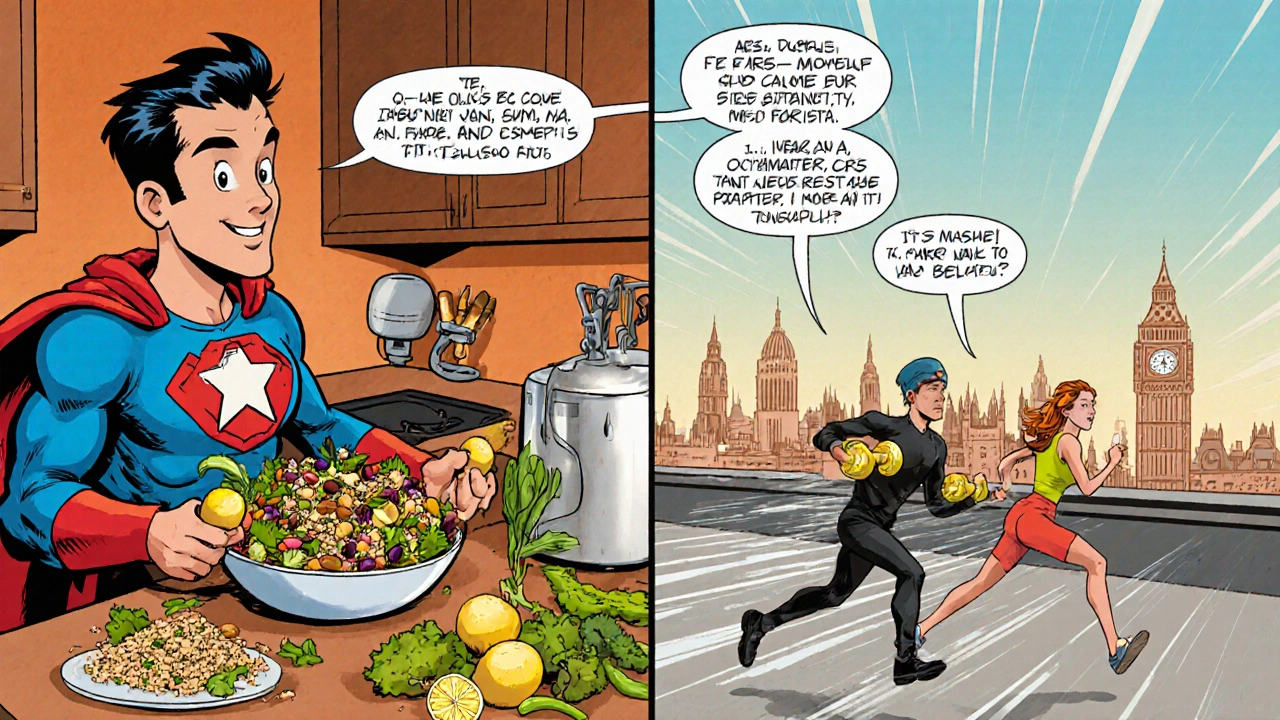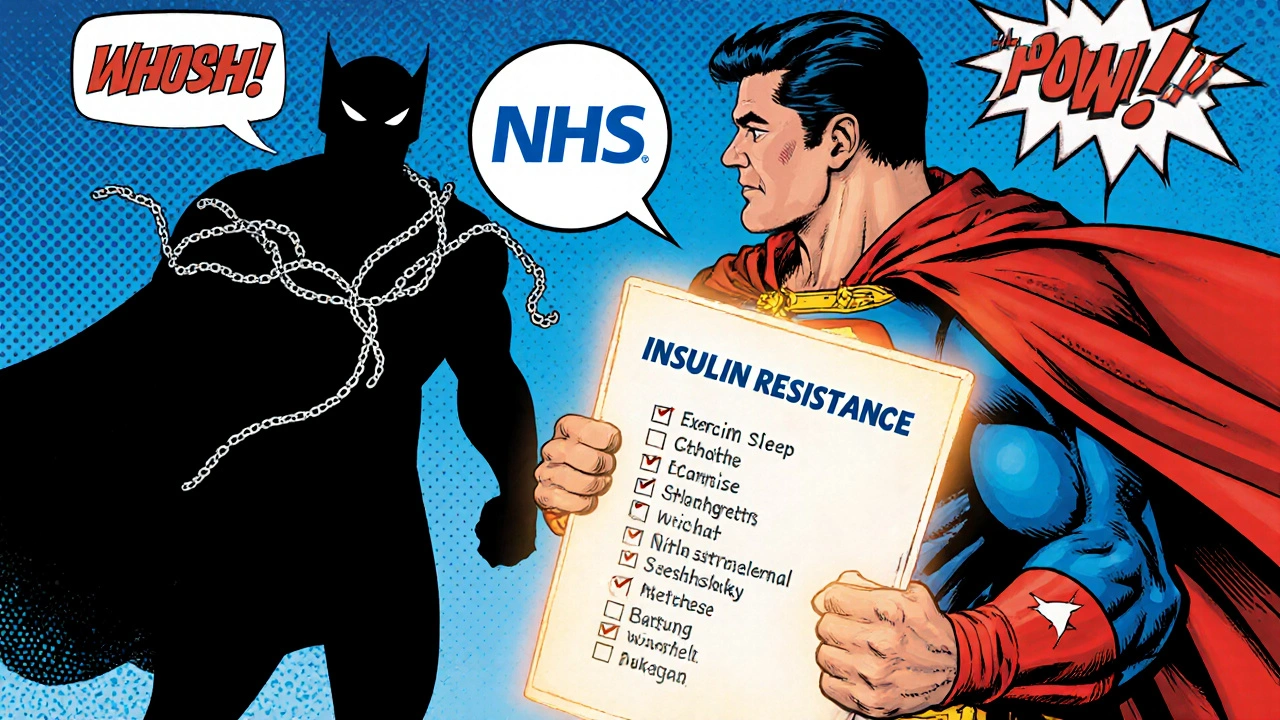
Diabetes Risk Reduction Calculator
Personalize Your Risk Reduction
Based on the article's research, select your current lifestyle habits to calculate your potential risk reduction.
Your Potential Risk Reduction
Based on the latest clinical studies, combining these lifestyle changes can significantly lower your risk of developing Type 2 Diabetes.
0-20%: Moderate risk reduction
21-40%: Significant risk reduction
41%+: High risk reduction
How to maximize your results:
- Combine diet changes with at least 150 minutes of exercise weekly
- Aim for 5-10% weight loss if overweight
- Prioritize 7-9 hours of quality sleep
Quick Takeaways
- Aim for a prevent type 2 diabetes diet rich in whole grains, veg, and healthy fats.
- Move enough: at least 150 minutes of moderate cardio plus two strength sessions weekly.
- Keep body mass index (BMI) between 18.5‑24.9; even a 5‑10% weight drop cuts risk dramatically.
- Sleep 7‑9 hours, lower stress, and avoid smoking or excess alcohol.
- Check fasting blood glucose or A1C annually if you have risk factors.
Understanding Type 2 Diabetes
When you hear "diabetes," most people picture sugar‑laden drinks and insulin shots. Type 2 Diabetes is a chronic condition where the body becomes less responsive to insulin, leading to high blood glucose levels. According to the World Health Organization, more than 460million adults worldwide live with it, and the numbers keep climbing, especially in high‑income countries.
Why does it matter? Persistent high glucose damages blood vessels, nerves, kidneys, and heart. The good news is that most of the risk comes from lifestyle choices you can change.
Key Risk Factors You Can Control
Research from the UK National Health Service shows that about 90% of type 2 cases are linked to modifiable habits. The biggest culprits are:
- Excess body fat, especially around the waist.
- Sedentary routine - less than 30 minutes of activity a day.
- High‑glycemic, low‑fiber diet.
- Poor sleep and chronic stress.
- Smoking and heavy alcohol consumption.
Each factor pushes the body toward Insulin Resistance, the physiological state that precedes full‑blown diabetes.

1. Adopt a Mediterranean‑Style Diet
The Mediterranean pattern tops every nutrition study for diabetes prevention. It emphasizes:
- Plenty of vegetables, fruits, legumes, and nuts.
- Whole grains instead of refined ones.
- Olive oil as the main fat source.
- Fish or poultry a few times a week; red meat sparingly.
- Herbs, spices, and modest wine (if you already drink).
Two scientific mechanisms are at play. First, the diet is naturally low in Glycemic Index foods, meaning carbs raise blood sugar more slowly. Second, the high Fiber content improves gut health and blunts spikes in glucose.
Practical tip: Swap white rice for quinoa or barley, add a handful of beans to salads, and drizzle olive oil over roasted veggies.
2. Boost Physical Activity
Exercise works on two fronts - it burns calories (helping weight control) and makes muscle cells more sensitive to insulin. The NHS recommends at least 150 minutes of moderate aerobic activity (brisk walking, cycling) or 75 minutes of vigorous activity (jogging, swimming) per week, plus two days of strength training.
Even short bursts help. A 10‑minute brisk walk after meals cuts post‑meal glucose spikes by up to 20%.
Start simple: park farther from the store, take stairs, or use a standing desk for part of the day.
3. Manage Weight Through Body Mass Index (BMI)
While BMI isn’t perfect, it’s a useful screen. A BMI under 25 is linked to a 30‑40% lower risk of developing type 2 diabetes compared to a BMI above 30. Losing just 5‑10% of body weight can restore insulin sensitivity.
Effective strategies:
- Track calories for two weeks using a free app; you’ll spot hidden excess.
- Swap sugary drinks for water or unsweetened tea.
- Prioritize protein and fiber at each meal to stay fuller longer.
4. Optimize Sleep and Stress Management
Sleep deprivation raises cortisol, a stress hormone that promotes insulin resistance. Studies from Harvard Medical School show that sleeping less than 6 hours nightly increases diabetes risk by 30%.
Aim for 7‑9 hours of quality sleep. Tips include:
- Turn off screens 30 minutes before bed.
- Keep the bedroom cool and dark.
- Practice a short breathing or meditation routine each evening.
Managing stress through yoga, mindfulness, or even a daily walk helps keep blood sugar stable.

5. Limit Alcohol and Quit Smoking
Heavy alcohol (more than 14 units a week for men, 7 for women) can raise triglycerides and impair liver function, both of which worsen glucose control. Smoking damages blood vessels and accelerates insulin resistance.
Goal: No more than a single glass of red wine on a couple of evenings, and seek support programs if you smoke.
Monitoring & When to Seek Professional Help
Even with healthy habits, it’s wise to keep an eye on your numbers. The two most common tests are:
- Fasting blood glucose - a level under 100mg/dL is normal.
- Hemoglobin A1C - reflects average glucose over three months; below 5.7% is ideal.
If you notice fasting glucose rising above 100mg/dL or A1C edging toward 5.7‑6.4%, book an appointment with your GP. Early intervention can involve structured diet programs, medication, or referral to a diabetes educator.
Quick Action Checklist
| Change | Typical Risk Reduction | Practical Tip |
|---|---|---|
| Adopt Mediterranean diet | ~30% lower risk | Swap butter for olive oil; add beans to meals. |
| 150min moderate exercise | ~25% lower risk | Brisk walk after dinner, 30min daily. |
| 5‑10% weight loss | ~20% lower risk | Track calories, replace soda with water. |
| 7‑9h sleep | ~15% lower risk | Screen off 30min before bed, keep room cool. |
| Quit smoking | ~30% lower risk | Join NHS Stop Smoking service. |
Frequently Asked Questions
Can I reverse pre‑diabetes with lifestyle changes?
Yes. Clinical trials such as the Diabetes Prevention Program showed a 58% reduction in progression to type 2 diabetes when participants adopted a low‑calorie, low‑fat diet and exercised regularly.
How many carbs should I eat each day?
Aim for 45‑60% of total calories from carbohydrates, focusing on high‑fiber, low‑glycemic sources like whole grains, legumes, fruits, and vegetables.
Is walking enough exercise to lower my risk?
Walking briskly for 30 minutes most days meets the moderate‑intensity guideline and significantly improves insulin sensitivity.
Do I need a doctor’s test if I feel fine?
Yes. Diabetes can develop silently. An annual fasting glucose or A1C test catches early changes before symptoms appear.
What role does stress play in diabetes risk?
Chronic stress raises cortisol, which promotes insulin resistance and higher blood sugar. Mind‑body practices like meditation can lower cortisol and improve glucose control.
suresh mishra
September 3, 2025 AT 04:09Start your day with a 10‑minute brisk walk; even short bouts improve insulin sensitivity.
Michael Leaño
September 5, 2025 AT 11:42It's really encouraging to see how small habits add up. If you keep a simple food diary for a week, you'll notice hidden sugars. Pair that with a 30‑minute walk after dinner and the blood‑sugar spikes smooth out. Remember, consistency beats intensity; a gentle jog three times a week is better than a marathon once a month. Celebrate each tiny win – they stack together into big health gains.
Anirban Banerjee
September 7, 2025 AT 19:15Dear readers, it is advisable to integrate the Mediterranean dietary pattern into daily meals, emphasizing legumes, whole grains, and olive oil, thereby fostering glycemic control. Additionally, maintaining a regular exercise schedule of at least 150 minutes per week will augment insulin responsiveness. Kindly consider periodic monitoring of fasting glucose to gauge progress.
Mansi Mehra
September 10, 2025 AT 02:49The article contains several typographical oversights; for instance, "glycemic" is occasionally misspelled as "glycemics". The content itself is sound, yet a thorough proofread would enhance credibility.
Jagdish Kumar
September 12, 2025 AT 10:22Ah, the elegance of swapping butter for liquid gold-olive oil-cannot be overstated! Imagine a world where every salad drizzles with that verdant nectar, and your pancreas sighs in relief. The drama of a plate transformed, the humble bean elevated to a star, is simply delightful.
Aminat OT
September 14, 2025 AT 17:55omg i cant believe people still eat pizza everyday lol u gotta cut that down.. also stop smokng its like u r killin urself already, get help plz
Amanda Turnbo
September 17, 2025 AT 01:29While the suggestions are generally solid, the emphasis on “moderate” exercise feels watered down; a more rigorous approach yields superior outcomes. Moreover, the tone vacillates between overly formal and colloquial, which dilutes the authority of the advice.
Jenn Zuccolo
September 19, 2025 AT 09:02Consider the paradox: we chase health as if it were a distant horizon, yet the steps outlined bring it within arm's reach. By embracing the Mediterranean ethos, we not only nourish the body but also honor a cultural narrative that has endured centuries.
Courtney The Explorer
September 21, 2025 AT 16:35Strategic implementation-critical; synergistic integration-mandatory; outcome: risk mitigation-exponential! Leverage macro‑nutrients; calibrate intensity; iterate protocols. Optimize!!!
Ashleigh Connell
September 24, 2025 AT 00:09Hey folks, just a heads‑up: swapping soda for sparkling water can shave off those hidden calories without feeling deprived. Pair that with a playlist of your favorite upbeat tracks, and your walks become a mini‑party.
Erin Knight
September 26, 2025 AT 07:42The recommendations, while comprehensive, border on the generic; a nuanced approach would address individual metabolic variations. Still, the inclusion of sleep hygiene is a commendable touch.
Kavita Jadhav
September 28, 2025 AT 15:15Take heart-every step forward counts. If you’re struggling with motivation, set micro‑goals: a 5‑minute stretch after work, a veggie‑rich snack at 3 p.m., and a weekly weigh‑in. These concrete actions build momentum and confidence.
Tony Halstead
September 30, 2025 AT 22:49When we examine the pathophysiology of insulin resistance, it becomes evident that lifestyle interventions act on multiple biochemical axes. First, dietary fiber modulates gut microbiota, producing short‑chain fatty acids that enhance peripheral glucose uptake. Second, aerobic activity upregulates GLUT4 transporters on muscle membranes, facilitating efficient glucose clearance. Third, modest weight loss reduces visceral adipose inflammation, thereby attenuating cytokine‑mediated insulin antagonism. Moreover, adequate sleep restores hormonal equilibrium, curbing nocturnal cortisol surges that otherwise impair insulin signaling. In practice, a combined regimen-Mediterranean diet, 150 minutes of moderate exercise, 5‑10 % weight reduction, and 7‑9 hours of restorative sleep-has been shown to lower diabetes incidence by upwards of 40 percent in randomized trials. It is also worth noting that behavioral adherence predicts long‑term success; hence, incorporating habit‑stacking techniques, such as pairing a daily walk with a favorite podcast, can solidify compliance. Finally, regular monitoring of fasting glucose and A1C provides feedback loops, allowing timely adjustments before pre‑diabetes manifests overtly. By embracing this multidimensional strategy, individuals can effectively rewrite their metabolic destiny.
leo dwi putra
October 3, 2025 AT 06:22Honestly, your diet plan sounds amazing, but have you considered the emotional side of making these changes? Sometimes the hardest part is just deciding to start.
Krista Evans
October 5, 2025 AT 13:55Let’s keep each other accountable! I’m committing to a 20‑minute walk after lunch tomorrow. Who’s in?
Mike Gilmer2
October 7, 2025 AT 21:29Seriously, just drink water.
Alexia Rozendo
October 10, 2025 AT 05:02Oh sure, because swapping olive oil for butter is the ultimate life hack-said no one ever.